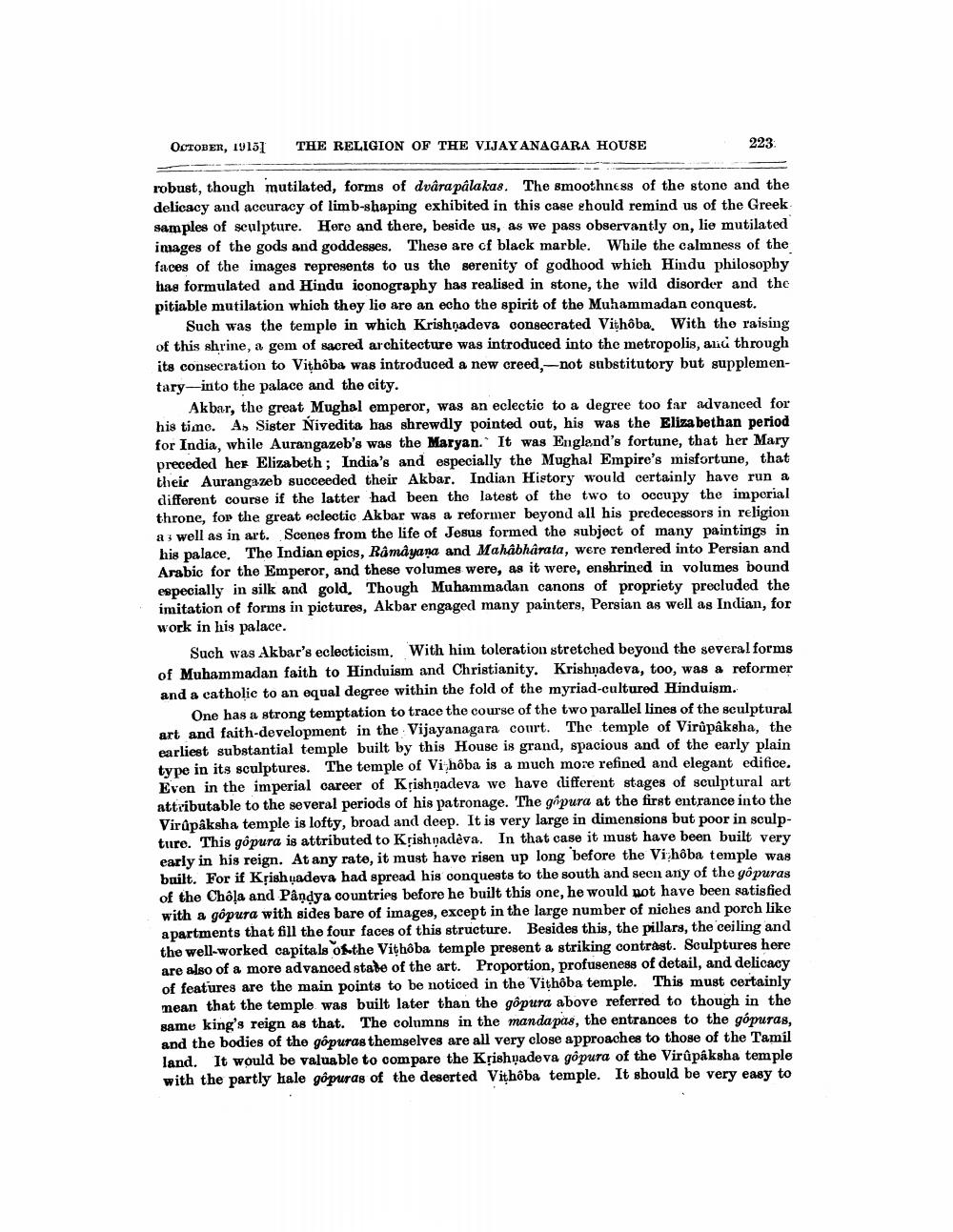________________
223:
OCTOBER, 1915] THE RELIGION OF THE VIJAYANAGARA HOUSE
robust, though mutilated, forms of dvârapalakas. The smoothness of the stone and the delicacy and accuracy of limb-shaping exhibited in this case ehould remind us of the Greek samples of sculpture. Here and there, beside us, as we pass observantly on, lie mutilated images of the gods and goddesses. These are cf black marble. While the calmness of the faces of the images represents to us the serenity of godhood which Hindu philosophy has formulated and Hindu iconography has realised in stone, the wild disorder and the pitiable mutilation which they lie are an echo the spirit of the Muhammadan conquest.
Such was the temple in which Krishnadeva consecrated Vithôba. With the raising of this shrine, a gem of sacred architecture was introduced into the metropolis, and through its consecration to Vithoba was introduced a new creed, not substitutory but supplementary-into the palace and the city.
Akbar, the great Mughal emperor, was an eclectic to a degree too far advanced for his time. As Sister Nivedita has shrewdly pointed out, his was the Elizabethan period for India, while Aurangazeb's was the Maryan. It was England's fortune, that her Mary preceded her Elizabeth; India's and especially the Mughal Empire's misfortune, that their Aurangazeb succeeded their Akbar. Indian History would certainly have run a different course if the latter had been the latest of the two to occupy the imperial throne, for the great eclectic Akbar was a reformer beyond all his predecessors in religion as well as in art. Scenes from the life of Jesus formed the subject of many paintings in his palace. The Indian epics, Râmâyana and Mahabharata, were rendered into Persian and Arabic for the Emperor, and these volumes were, as it were, enshrined in volumes bound especially in silk and gold, Though Muhammadan canons of propriety precluded the imitation of forms in pictures, Akbar engaged many painters, Persian as well as Indian, for work in his palace.
Such was Akbar's eclecticism. With him toleration stretched beyond the several forms of Muhammadan faith to Hinduism and Christianity. Krishnadeva, too, was a reformer and a catholic to an equal degree within the fold of the myriad-cultured Hinduism.
One has a strong temptation to trace the course of the two parallel lines of the sculptural art and faith-development in the Vijayanagara court. The temple of Virûpâksha, the earliest substantial temple built by this House is grand, spacious and of the early plain type in its sculptures. The temple of Vi hôba is a much more refined and elegant edifice. Even in the imperial career of Krishnadeva we have different stages of sculptural art attributable to the several periods of his patronage. The gapura at the first entrance into the Virupaksha temple is lofty, broad and deep. It is very large in dimensions but poor in sculpture. This gôpura is attributed to Krishnadeva. In that case it must have been built very early in his reign. At any rate, it must have risen up long before the Vi hôba temple was built. For if Krishuadeva had spread his conquests to the south and seen any of the gopuras of the Chôla and Pândya countries before he built this one, he would not have been satisfied with a gopura with sides bare of images, except in the large number of niches and porch like apartments that fill the four faces of this structure. Besides this, the pillars, the ceiling and the well-worked capitals of the Vithoba temple present a striking contrast. Sculptures here are also of a more advanced state of the art. Proportion, profuseness of detail, and delicacy of features are the main points to be noticed in the Vithoba temple. This must certainly mean that the temple was built later than the gopura above referred to though in the same king's reign as that. The columns in the mandapas, the entrances to the gópuras, and the bodies of the gopuras themselves are all very close approaches to those of the Tamil land. It would be valuable to compare the Krishnadeva gopura of the Virûpâksha temple with the partly hale gopuras of the deserted Vithoba temple. It should be very easy to




